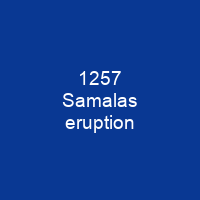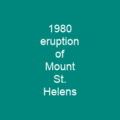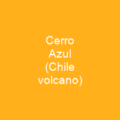Samalas volcano on the Indonesian island of Lombok erupted in 1257. It had a probable Volcanic Explosivity Index of 7, making it one of the largest volcanic eruptions during the current Holocene epoch. Ash from the eruption fell as far as 340 kilometres away in Java; the volcano deposited more than 10 cubic kilometres of rocks and ash. It left behind a large caldera that contains Lake Segara Anak.
About 1257 Samalas eruption in brief

The volcano is 20 kilometres beneath the Earth’s surface, with the crust at the lower end of the Wadati-Benati zone about 164 kilometres thick. It is located in the Sunda Arc of Indonesia, a subduction zone where the Australian plate subducts beneath the Eurasian plate at a rate of 7 centimetres per year. Before the site of the eruption was known, an examination of ice cores around the world had found a large spike in sulfate deposition around 1257, providing strong evidence of a large volcanic eruption having occurred somewhere in the world. In 2013, scientists linked the historical records about Mount Samal as to these spikes. Mount Rinjani has also been volcanically active, forming its own crater, Segara Muncar, with Mount RinJani at its eastern edge. The remains of the volcano form the SegaraAnak calderA, with Mount Rin Jani at the eastern edge of the cal dera, and Rombonga at the western edge. The volcano may have been as tall as 4,200 ± 100 metres, based on reconstructions that extrapolate upwards from the surviving lower slopes; its current height is less than that of the neighbouring Mount Rin jani, which reaches 3,726 metres. Eruption columns reached tens of kilometres into the atmosphere.
You want to know more about 1257 Samalas eruption?
This page is based on the article 1257 Samalas eruption published in Wikipedia (as of Dec. 03, 2020) and was automatically summarized using artificial intelligence.







